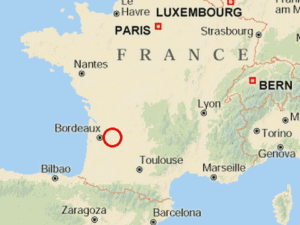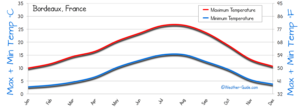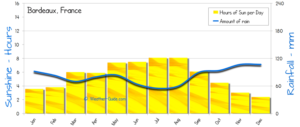Fàilte! Welcome to the next installment of Exploring the Wine Glass. Mike and I are big proponents of you should drink what you like and you are the only one who can taste like you. We advocate the fact that everyone experiences the wine differently, so in these posts we do not discuss our tasting notes. Instead we include basic information about each of the wineries, and/or a bit about what was happening in our lives while we were enjoying them.
Want to know what we think of the wines? Do you want a little insight into our palates? Then head over to Delectable and check us out. We tell it as we taste it over there. A video of them as they are poured is found at the end of the post. Visit our YouTube Channel to see other wine videos. As always, since as oenophiles we love to celebrate #WineWednesday, our week runs from one Wednesday to the next.
This edition is going to be a bit different from all the others. I am beyond excited to be heading to France. I’ll be spending one week in Paris with Mike and then heading to Bordeaux for En Premieur Week. In all honesty, I have no idea what to expect. I have reached out to my friends Michelle Williams and Jeff Burrows who both won the Millesima Blog Awards previously to ask their advice and share their experiences. They provided me with so much information, but I still am on edge about what I am about to experience!
A Bit about Bordeaux
As is typical with me, I am a true Sagittarius through and through, once I learned that I had won this amazing award for my blog, I dove into France with both feet! I have been running to the wine shop on a regular basis (which isn’t anything all that different) but what is different is what aisles I walked down. I think I have tasted more Old World wines in these past two months than I have done ever. What I did learn was that, yes, I still would classify myself as having a New World palette, but I am quickly gaining an appreciation for certain Old World styles. Hey, it’s a start, right?!
If asking an oenophile what are the top wine regions of the world, there is no doubt that Bordeaux will be one of the top three mentioned. Champagne would probably be number one and I think Napa would be in there also. I would also personally add Alsace and Rias Baixas and of course Paso! (but I am pretty partial to that!)

Bordeaux is known for its vineyards and is located in the southwest region of France, not far from the Bay of Biscay. There are over 100,000 vineyards in the region. Bordeaux is a crescent-shaped city located along the Garonne River. It has been the region’s wine capital for decades. Bordeaux has a population of 231,844 making it the biggest city in Aquitaine. What was once a rather polluted, heavily trafficked urban area, has become THE destination for wine, with revitalized villages, magnificent architecture and a pedestrian focused city center. Don’t forget theater, art and award-winning dining.
I Think I’m Going to Be Chilly
And….. a wee bit wet. Generally speaking, Bordeaux’s climate is an oceanic climate. Similar to a Mediterranean climate, except with more substantial rainfall in the summer. Basically, summers tend to be warm with mild winters. There are westerly winds from the Atlantic Ocean that cool the region in the winter. The Bay of Biscay influences the summer temperature. What this means is that on average, the temperature in the winter is about 44oF and summer temperatures are about 69oF. But, as Michelle told me, who is just returning from the area, “50 degrees is lovely when it’s sunny and there is no wind, but when it’s raining all day every day 50 degrees is cold.” So I am preparing for damp cool weather by packing many layers!


Wine and Bordeaux
It is believed that grape vines were introduced by the ancient Romans. They were the first to cultivate and produced Bordeaux wine way back in about 60 BC. There are remains of the Palais Gallien Amphitheatre dating back to this time period still visible in Bordeaux. More remnants of this period of time can be found on both the Left and Right Banks as well as in Graves.
By the first century, Bordeaux was already entering their stride for producing wine. The wines were produced and distributed to Roman soldiers. Pliny the Elder often mentioned the vines in Bordeaux in his writings. Further evidence of wine during this period can be found in writings on Amphorae in Pompeii.
It is believed that Bordeaux producers originally transported vines from Rioja. They found that the soil and marine climate in Bordeaux was ideal for growing wine grapes, plus having the Gironde River nearby allowed for easy transportation of the finished product.
1855.. A Very Important Year
Bordeaux is not small. With about 115,000 hectares (280,000 acres) of vineyards, 57 appellations, and 10,000 chateaux the region is quite impressive. It is estimated that there are over 950 million bottles of Bordeaux wine produced every year, and many of them are classified as some of the most expensive wines in the world.
These expensive wines have the distinction of being classified as one of the five Premier Crus (first growth) for red wines (four from Médoc and one, Château Haut-Brion, from Graves), established by the Bordeaux Wine Official Classification of 1855: whose purpose was to promote Bordeaux wine and to allow consumers to know where to find these wines. It also provided them with a guide sheet of what they should pay for this superior wine.
After The Exposition Universelle de Paris,where the best of the best French wines were displayed, the Gironde Chamber of Commerce decided that there now needed to be an official classification created to promote the famous wines. They created a panel of distinguished negociants and brokers who created the now famous 1855 Bordeaux wine classification. In fact, in over 160 years, this classification has only been modified twice. Read more about the classification in this great article by winecellarinsider.
Right vs. Left
Paso Robles has the East and West Side. There are major differences between the water table and the soils found between these two areas, and they are only separated by a freeway. In Bordeaux, instead of a street dividing the region, there is a river, technically an estuary. The Gironde Estuary. When looking at a map of southwestern France, you can see an upside-down Y cutting through Bordeaux territory. The Gironde Estuary, is the straight portion of the “Y” while the arms are the Dordogne and the Garonne rivers. The southwest side of the Gironde is the Left Bank, while the Northeast side is the Right Bank.

The differences between the two banks are clearly discussed on International Fine Wines‘ website:
The Left Bank: literally the left edge of any map of the region, is situated on the western banks of Gironde Estuary/Garonne river and includes the appellations of St-Estèphe, Pauillac, St-Julien, Listrac, Moulis, Margaux (sometimes these former are all lumped together as the “Medoc”), Pessac-Leognan/Graves and, perhaps, Sauternes/Barsac. Here the red wines are typically based on Cabernet Sauvignon with varying degrees of Merlot, Cabernet Franc and sometimes small quantities of Malbec and/or Petit Verdot. The most famous whites of Bordeaux are produced in the Left Bank; in the Pessac/Graves area, made from Sauvignon Blanc and Semillon; typically a blend of the two and sometimes with a dollop of Muscadelle (rarely more than a few percent if at all). These are the grape varieties also used in the legendary sweet wines: Sauternes and Barsac (also theoretically Left Bank wines) and the other sweet wines of the region. The soil profile of the left bank is, in general, very stony, pebbly, gravel topsoil, with various degrees of sand and clay, over limestone bedrock.
The Right Bank: is situated some way to the east, at the tail-end of the Dordogne and includes the appellations of St Emilion, Pomerol, Fronsac, amongst others. Here Merlot is king and Cabernet Franc plays a much greater role. In fact, in a small number of the most famous right bank domains such as Ausone, Cheval Blanc, Angelus and Lafleur, Cabernet Franc makes up roughly half the blend. Cabernet Sauvignon is used very sparingly on the right bank, making up only 7% of total plantings. The resulting wines are sometimes more opulent, less structured and better drinking early (although this is a generalisation). In fact it is often very difficult, when tasting blind, to differentiate between left bank and right bank, Cabernet and Merlot dominant wines. It tends to be the regions or soils that speak louder than the grape – but this is for another article. The soils here are generally (but not always) less gravely, limestone is now at the surface and there is more influence of clay and sand.
You can also watch this 45 second video by VinePair.
Yes, There is White in Bordeaux
Although, red wine is what comes to mind when you hear Bordeaux, there is also white. In general, red wines are typically made from a blend of grapes, including Cabernet Sauvignon, Merlot, Cabernet Franc (woo hoo!) , Petit verdot, Malbec, and, recently, although less common, Carménère.
White Bordeaux is made from Sauvignon blanc, Sémillon, and Muscadelle. There is also a sub-region of Graves known Sauternes that is known for its intensely sweet, white, dessert wines such as Château d’Yquem. It is estimated that about 10% of all Bordeaux wine is white and close to four million cases produced annually and I found one that I absolutely adore! Read about my 2016 Chateau DeCarolle tasting experience in my Emotion. Not Money or Age for this #OTBN 
This is going to be an exciting time for me. One I actually never thought would be one that I would experience. So thank you to Millesima for choosing me as a finalist and to all my readers and followers for helping to get me here! Please let me know if you have a favorite Bordeaux wine and if you prefer the Left or the Right Bank!
If you haven’t had a Bordeaux wine in a while, please grab one and uncork this week with me! I hope you have had some great wines and times these past two weeks. Remember, always Pursue Your Passion. We would love for you to leave a comment telling us what your favorite recent wine was.
~Sláinte
Dracaena Wines now has a Wine Club! We named it the CHALK CLUB. Draco is on our label, but Vegas was getting a little jealous. So we decided he deserved to be club spokesdog. In Las Vegas, betting CHALK means you are betting on all the favorites. We are betting that we are one of your favorite wineries, so we thought the name was apropos. The club is simple yet a bit different than most. When you wager on us, we will ship you three bottles of wine twice a year; once in April and once in September. You can choose all red or a mix of red and rose’. You immediately receive 15% off ALL your wine purchases but what makes our club stand out is a progressive discount. Let your club membership ride into the next year, your discount increases. Each year you parlay your membership, you receive an additional 5% off up to a plan maximum of 25%. Your club shipments are discounted. Flat $15 shipping PLUS we’ll cover your club shipping cost for your second shipment. That is $15 house money in a sure bet for you! So please head to our website; www.dracaenawines.com/chalk-club to find out all of the benefits of joining the CHALK CLUB and to sign up. We’ve stacked the odds so that you can get our award-winning wines without breaking the bank.

A fabulous overview of Bordeaux Lori. Sounds like you’ve had fun shopping for and diving into the wine! What Michelle says about 50 degrees in Bordeaux is absolutely true, so I do hope it gets a little warmer for you. Congrats again and have a fantastic wine time 😉
Thank you so much Lynn! I can’t wait to see Bordeaux and have this experience. We are currently in Paris and wet and 50 is DEFINITELY not fun! Thanks goodness I have layers!
I am so excited for you. Yes, wet and cold. That is spring in Bordeaux. Good for grapes, not for women’s hair styles. I am also so pleased your palate is broadening. As a winemaker I believe the broader your palate the better the wine you make. I do take one exception with your categorization of top world wine regions. I agree solely that Bordeaux and Champagne would be up there but believe Burgundy would easily be top three, arguable number one, depending on who you ask. Burgundy does produce the most expensive white and red wines in the world. You will also get a heavy dose of Bordeaux’ maritime climate (not sure what oceanic is, not part of WSET) conversation with the 2017 vintage. Late frost proved unkind to many vineyards, some lost their entire production. You are going to have a great time, you will learn a lot, and be well taken care of by my Millesima friends.
Thank you so much Michelle! For all of your constant support and help with what to expect. I think Burgundy is a top wine region, but for some reason does not come up as much in a conversation as Bordeaux and definitely as with Champagne. (agree – with whom you are having the conversation with.) Thanks again!
A truely great overview with historical hindsight. I somehow missed the fact that producers brought vines all the way up from Rioja. Good to know.
Thank you. It’s always fun learning new wine facts!